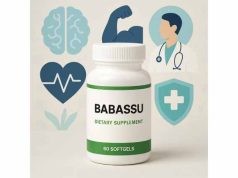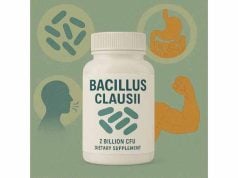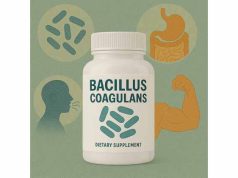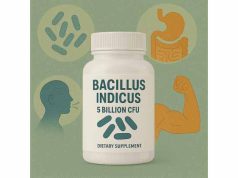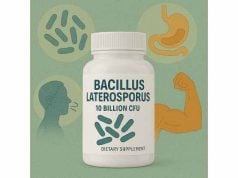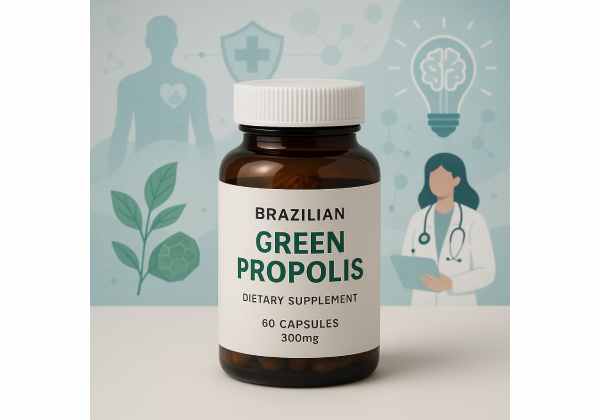
Brazilian green propolis has captivated the attention of both traditional healers and modern wellness enthusiasts for its extraordinary natural health benefits. Sourced from the resinous exudate of Baccharis dracunculifolia—a wild plant native to Brazil—this unique propolis boasts a rich array of flavonoids, phenolic acids, and powerful bioactive compounds not found in other types of propolis. Valued for its potent antioxidant, antimicrobial, and immune-modulating actions, Brazilian green propolis is widely used to support immunity, soothe inflammation, promote oral and skin health, and defend the body against environmental stressors. This comprehensive guide explores the science, evidence, practical uses, safety, and best practices for harnessing Brazilian green propolis for optimal health.
Key Takeaways
- Brazilian green propolis contains unique antioxidants and bioactive compounds that may help boost immune function and combat inflammation.
- Research suggests benefits for wound healing, oral health, upper respiratory infections, and overall immunity.
- Its distinct plant source (Baccharis dracunculifolia) sets it apart from other propolis types, with a high concentration of artepillin C and related phenolics.
- Quality and standardization matter—look for standardized extracts with known artepillin C content for best results.
- Not suitable for people with bee product allergies; some mild digestive or allergic reactions may occur in sensitive individuals.
Table of Contents
- Brazilian Green Propolis Overview: Origin, Plant Source, and Composition
- Mechanisms of Action: Unique Compounds and Biological Effects of Brazilian Green Propolis
- Evidence-Based Benefits: Key Health Uses of Brazilian Green Propolis
- Brazilian Green Propolis Safety, Tolerability, and Possible Interactions
- Optimal Dosage, Usage, Timing, and Best Practices for Brazilian Green Propolis
- Frequently Asked Questions About Brazilian Green Propolis
Brazilian Green Propolis Overview: Origin, Plant Source, and Composition
Brazilian green propolis is a unique bee-derived substance with origins in the lush, unspoiled regions of Brazil, where bees collect resin from the Baccharis dracunculifolia shrub. Unlike European or Asian propolis, which come from a variety of trees and shrubs, Brazilian green propolis owes its signature color and robust health effects to this single, dominant plant source.
What is Propolis?
Propolis is a natural resinous compound produced by honeybees from plant resins, beeswax, and their own enzymes. Used by bees to protect the hive, propolis acts as a powerful antimicrobial barrier, keeping the colony healthy and disease-free. Humans have long prized propolis for its medicinal value in traditional and natural medicine.
What Makes Brazilian Green Propolis Unique?
- Baccharis dracunculifolia as the Main Source: This wild bush, found in southeast Brazil, provides a resin rich in specific phenolics and flavonoids, creating the green color and a distinctive phytochemical profile.
- Artepillin C: Brazilian green propolis is particularly high in artepillin C, a rare phenolic acid with potent antioxidant, antimicrobial, and anti-inflammatory effects—largely responsible for its acclaimed health properties.
- Rich in Flavonoids and Phenolic Acids: Includes compounds such as caffeic acid, p-coumaric acid, and kaempferide, all contributing to its strong antioxidant and biological actions.
Physical Characteristics and Taste
- Color: Vivid green, often with golden hues due to high chlorophyll and polyphenol content.
- Flavor: Earthy, resinous, with a slightly bitter aftertaste. This potent flavor can be a hallmark of authenticity and concentration.
How Is It Collected and Produced?
- Bees harvest resin from Baccharis dracunculifolia and mix it with wax and enzymes.
- Raw propolis is then extracted using food-grade alcohol or water to create concentrated liquid, powder, or capsule supplements.
- High-quality brands standardize for artepillin C content, often labeled in milligrams per dose.
Traditional and Modern Uses
- Traditionally used in Brazilian folk medicine for infections, wounds, sore throats, and inflammation.
- Now popular worldwide for immune support, oral and skin care, and as a general wellness booster.
Sustainability and Ethical Sourcing
- Sustainably sourced Brazilian green propolis supports local beekeepers and rainforest conservation.
- Look for certifications such as organic, non-GMO, and fair-trade when choosing a supplement.
Summary
Brazilian green propolis is a potent, unique bee product distinguished by its Amazonian plant source and rich concentration of rare phenolics, delivering health properties beyond those of other propolis types.
Mechanisms of Action: Unique Compounds and Biological Effects of Brazilian Green Propolis
The distinctive therapeutic properties of Brazilian green propolis stem from its abundant and unique bioactive compounds, most notably artepillin C. Understanding how these natural molecules interact with the human body sheds light on its wide-ranging health effects.
1. Antioxidant Activity
- Artepillin C and Flavonoids: Artepillin C, along with kaempferide and other flavonoids, acts as a powerful free radical scavenger. This helps protect cells from oxidative stress—a key factor in aging and chronic disease.
- Cellular Defense: These antioxidants also help recycle other antioxidants like vitamin C and E, supporting a robust cellular defense network.
2. Anti-Inflammatory Properties
- Inflammatory Pathway Modulation: Brazilian green propolis compounds can inhibit enzymes and cytokines responsible for inflammation, helping calm inflammatory responses in tissues and joints.
- Potential Applications: May benefit conditions marked by excessive inflammation, such as sore throat, arthritis, and autoimmune disorders.
3. Antimicrobial and Antiviral Actions
- Broad-Spectrum Defense: Brazilian green propolis exhibits potent activity against bacteria, viruses, and fungi. This makes it valuable for oral hygiene, upper respiratory health, and skin protection.
- Biofilm Disruption: Compounds in propolis can prevent bacteria from forming biofilms—a defensive layer that makes infections harder to treat.
4. Immune System Modulation
- Balancing Immunity: Rather than simply stimulating immunity, Brazilian green propolis helps regulate immune responses, supporting defense against infection without excessive immune activation.
- Support for Immune Cell Function: Enhances the activity of macrophages and natural killer cells, crucial players in the body’s defense system.
5. Wound Healing and Tissue Regeneration
- Collagen Stimulation: Flavonoids and phenolic acids in propolis can promote collagen synthesis and accelerate wound closure.
- Antimicrobial Protection: Its antimicrobial activity helps keep wounds clean and free from infection, speeding up healing.
6. Additional Effects
- Gastroprotective: May protect stomach lining and support gut health by reducing inflammation and microbial imbalance.
- Neuroprotective Potential: Emerging evidence suggests artepillin C and related compounds may protect brain cells from oxidative and inflammatory damage.
Bioavailability and Absorption
- Alcohol-based tinctures often provide superior absorption of key phenolics.
- Encapsulated extracts may be better for those sensitive to alcohol or flavor.
Summary
Brazilian green propolis delivers multi-dimensional health effects, from defending against microbes and oxidative stress to calming inflammation and supporting tissue repair, making it a remarkable natural supplement.
Evidence-Based Benefits: Key Health Uses of Brazilian Green Propolis
Modern science and centuries of traditional use agree: Brazilian green propolis offers a wide range of health benefits, with research highlighting its particular strengths in immune defense, inflammation control, and natural healing.
1. Immune System Support and Infection Defense
- Cold and Flu Relief: Clinical studies show that Brazilian green propolis may reduce the duration and severity of upper respiratory infections, and support faster recovery.
- Antimicrobial Action: Effective against common bacteria (like Streptococcus mutans and Staphylococcus aureus), viruses (such as influenza), and fungi (including Candida).
2. Anti-Inflammatory Effects for Chronic and Acute Conditions
- Arthritis and Joint Health: Propolis supplements have been shown to ease symptoms of rheumatoid arthritis and other inflammatory conditions by modulating cytokine activity.
- Throat and Respiratory Inflammation: Used traditionally as a throat spray or lozenge for sore throats, propolis soothes mucous membranes and calms irritation.
3. Wound Healing and Skin Protection
- Accelerated Recovery: Applied topically, Brazilian green propolis supports faster wound closure and less scarring by promoting collagen and limiting microbial contamination.
- Burns, Ulcers, and Acne: Used for minor burns, pressure ulcers, and acne-prone skin to speed up healing and reduce infection risk.
4. Oral and Dental Health
- Cavity and Gum Disease Prevention: Propolis mouthwashes and toothpastes help reduce plaque, prevent cavities, and support healthy gums by inhibiting harmful bacteria and reducing inflammation.
- Mouth Ulcer Relief: May shorten healing time for canker sores and oral lesions.
5. Antioxidant and Anti-Aging Benefits
- Cellular Defense: Rich in antioxidants, Brazilian green propolis helps combat the cellular damage caused by pollution, UV radiation, and chronic stress.
- Longevity and Vitality: Animal studies suggest potential for healthy aging and cognitive protection, though more human data is needed.
6. Emerging Benefits
- Blood Sugar and Metabolic Support: Preliminary studies suggest propolis may support healthy blood sugar regulation and reduce risk factors for metabolic syndrome.
- Gastrointestinal Health: By controlling harmful bacteria and inflammation, propolis may help protect the gut lining and balance the microbiome.
Who Might Benefit?
- People prone to frequent colds, respiratory infections, or sore throats
- Those seeking natural support for gum, dental, or skin health
- Individuals with chronic inflammatory conditions
- Anyone looking for an antioxidant boost to counteract environmental stress
Summary
Brazilian green propolis is a natural powerhouse for immune support, healing, inflammation control, and protection against daily health stressors—making it an invaluable addition to your supplement toolkit.
Brazilian Green Propolis Safety, Tolerability, and Possible Interactions
Brazilian green propolis is prized for its natural healing properties and robust safety profile when used responsibly. However, as with any potent natural supplement, it’s important to understand who may be at risk of side effects, how to avoid potential reactions, and which drug or health condition interactions require caution.
General Tolerability and Side Effects
- Generally Well-Tolerated: Most adults tolerate Brazilian green propolis well, especially when taken within recommended dosages. It’s been used safely for generations in traditional Brazilian medicine.
- Mild Digestive Upset: Some individuals may experience mild stomach discomfort, nausea, or diarrhea when first starting propolis. These effects are typically transient and often resolve as the body adjusts.
- Allergic Reactions: As a bee product, propolis can trigger allergic reactions in people with bee or pollen allergies. Reactions range from mild itching or rashes to, rarely, swelling and anaphylaxis. Discontinue use immediately if any allergic symptoms occur.
Who Should Use Caution or Avoid Propolis?
- Individuals with Known Allergies: Anyone with allergies to bee stings, honey, or pollen should avoid propolis.
- Asthma Sufferers: People with asthma may be more likely to react to bee products, including propolis.
- Pregnant or Breastfeeding Women: There is limited safety data; consult a healthcare provider before use.
- Children: Not recommended for children under 1 year old due to potential allergenicity and the risk of infant botulism with some bee products.
Potential Interactions with Medications and Health Conditions
- Anticoagulant/Antiplatelet Drugs: Propolis contains natural compounds that may slightly thin the blood or affect platelet aggregation. Those on blood thinners (such as warfarin or aspirin) should consult a healthcare professional to avoid excessive bleeding risk.
- Immunosuppressive Medications: Since propolis may enhance immune function, it could potentially interfere with drugs that suppress the immune system after organ transplant or for autoimmune disease management.
- Allergy Medications: Some allergy medications may mask the symptoms of an early allergic reaction to propolis. Use with caution and monitor for signs of sensitivity.
Quality, Purity, and Standardization
- Look for Standardized Extracts: Choose supplements that clearly state the amount of artepillin C or total flavonoids per dose. Standardization ensures reliable potency and safety.
- Check for Purity and Third-Party Testing: Propolis can accumulate environmental toxins or pesticides from bee foraging areas. Reputable brands will provide third-party testing for contaminants.
- Avoid Unknown Sourcing: Inferior or counterfeit propolis may be adulterated or lack the signature bioactive compounds, offering little benefit and unknown risks.
How to Minimize Risk
- Start Low: Begin with the lowest recommended dose to assess your personal tolerance.
- Monitor for Reactions: Stop immediately if you experience itching, swelling, breathing difficulties, or any unusual symptoms.
- Check Medication Compatibility: If taking any prescription medication, discuss propolis use with your healthcare provider.
- Don’t Use if Allergic to Bee Products: If you’ve ever reacted to honey, royal jelly, or bee pollen, avoid Brazilian green propolis.
Summary
While Brazilian green propolis is remarkably safe for most, individual sensitivity, medication use, and the risk of allergic reactions must be considered. With responsible use and attention to product quality, most people can enjoy its health benefits safely.
Optimal Dosage, Usage, Timing, and Best Practices for Brazilian Green Propolis
Getting the most from Brazilian green propolis means understanding not just how much to take, but also when, how, and in which form to maximize its unique bioactive benefits. Here’s how to use this remarkable supplement safely and effectively.
General Dosage Guidelines
- Typical Oral Dose: Most adult supplements provide 200–500 mg of standardized Brazilian green propolis extract per day, usually split into 1–3 doses.
- Standardization: For targeted health effects (immune, antioxidant, oral care), look for products standardized to contain at least 5–10 mg artepillin C per daily dose.
- Liquid Extracts: A common liquid dosage is 10–30 drops, once or twice daily, diluted in water or juice. Always follow manufacturer or healthcare professional guidance.
How to Take Brazilian Green Propolis
- With or Without Food: Propolis can be taken on an empty stomach or with meals. Some people find it gentler with food, especially at higher doses.
- As a Mouthwash or Spray: For oral health, use propolis mouthwash or sprays directly in the mouth, following package directions.
- Topical Application: Creams or ointments containing standardized Brazilian green propolis can be applied to wounds, burns, or irritated skin for healing support.
Best Practices for Safe and Effective Use
- Consistency Matters: For immunity and general health, daily use over several weeks is often needed to notice effects. For acute issues (like sore throat), use at the first sign of symptoms.
- Adjust for Sensitivity: If you’re prone to allergies, start with a minimal dose and observe for any reactions before increasing.
- Cycle Use if Desired: Some users prefer to cycle propolis (e.g., 3 weeks on, 1 week off) to maintain effectiveness and minimize the risk of tolerance.
- Combine with a Healthy Lifestyle: Propolis works best alongside a nutrient-rich diet, good sleep, and other immune-supportive habits.
Special Considerations
- Children: Use only under pediatric supervision and at reduced dosages.
- Pregnancy/Breastfeeding: Consult a healthcare provider before use.
- Specific Health Conditions: Individuals with autoimmune diseases, bleeding disorders, or those undergoing organ transplantation should seek medical advice first.
Storage and Product Quality
- Store in a Cool, Dry Place: Keep away from direct sunlight and extreme temperatures to maintain potency.
- Shake Well Before Use: For liquid extracts, shake the bottle to evenly distribute the active compounds.
When to Expect Results
- Immune Support: Some users report fewer colds and infections after several weeks of consistent use.
- Oral/Topical Benefits: Mouth, throat, or skin improvements are often noticed within days to a week.
Avoiding Overuse
- Do not exceed recommended doses; higher amounts are not necessarily more effective and can increase the risk of digestive upset or allergic reactions.
Summary
Brazilian green propolis is versatile and easy to incorporate into a daily wellness routine. Prioritize standardized, high-quality extracts, follow dosage guidance, and tune into your body’s responses for the best results.
Frequently Asked Questions About Brazilian Green Propolis
What is Brazilian green propolis used for most commonly?
It’s most often used to support immune function, promote oral health, speed wound healing, and provide natural antioxidant and anti-inflammatory support.
Is Brazilian green propolis safe for daily use?
Yes, for most healthy adults, it’s safe when used within recommended dosages. Those with bee product allergies, asthma, or who are pregnant or breastfeeding should consult a healthcare provider first.
How should I take Brazilian green propolis for best results?
For immune support, take orally as capsules or liquid extract daily. For mouth or throat health, use a mouthwash or spray. For wounds, apply a propolis-containing cream or ointment topically.
Can I use Brazilian green propolis with other supplements or medications?
Generally, yes, but check with your doctor if you use blood thinners, immunosuppressants, or have allergies, as interactions or sensitivities may occur.
What are possible side effects of Brazilian green propolis?
Mild digestive upset or allergic reactions (itching, rash, swelling) can occur in sensitive individuals. Discontinue use and seek medical advice if you experience symptoms of an allergy.
Who should avoid Brazilian green propolis?
Those with allergies to bees, pollen, or honey, and individuals on blood thinners or with immune conditions, should avoid or use only under medical supervision.
How long does it take to notice benefits from Brazilian green propolis?
Benefits for oral or skin health may appear within days. Immune and antioxidant effects typically develop over several weeks of regular use.
Disclaimer:
The information provided in this article is for educational purposes only and does not constitute medical advice. Please consult your healthcare provider before starting any supplement, especially if you have allergies, chronic health conditions, or are taking prescription medications. Results and responses may vary.
If you enjoyed this guide, please share it with your friends or followers on Facebook, X (formerly Twitter), or your favorite social channel. Your support helps us keep delivering science-backed wellness content. Follow us for more health tips and supplement reviews!


